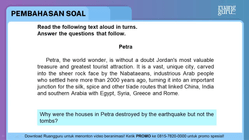Iklan
Iklan
Pertanyaan
Read the following text aloud in turns.
Answer the questions that follow.
Petra
Petra, the world wonder, is without a doubt Jordan's most valuable treasure and greatest tourist attraction. It is a vast, unique city, carved into the sheer rock face by the Nabataeans, industrious Arab people who settled here more than 2000 years ago, turning it into an important junction for the silk, spice and other trade routes that linked China, India and southern Arabia with Egypt, Syria, Greece and Rome.
Entrance to the city is through the Siq, a narrow gorge, over 1 km long, which is flanked on either side by soaring 80 m high cliffs. Just walking through the Siq is an experience in itself. The colors and formations of the rocks are dazzling. As you reach the end of the Siq, you will catch your first glimpse of Al-Khazneh (Treasury).
This is an awe-inspiring experience. A massive facade, 30 m wide and 43 m high, carved out of the sheer, dusky pink rock-face and dwarfing everything around it. It was carved in the early 1st century as the tomb of an important Nabataean king and represents the engineering genius of these ancient people.
The Treasury is merely the first of the many wonders that make up Petra. You will need at least four or five days to really explore everything here. As you enter the Petra valley, you will be overwhelmed by the natural beauty of this place and its outstanding architectural achievements. There are hundreds of elaborate rock-cut tombs with intricate carvings-unlike the houses, which were destroyed mostly by earthquakes, the tombs were carved to last throughout the afterlife and 500 have survived, empty but bewitching as you file past their dark openings. Here also is a massive Nabataean-built, Roman-style theater, which could seat 3.000 people. There are obelisks, temples, sacrificial altars and colonnaded streets, and high above, overlooking the valley, is the impressive Ad-Deir Monastery-a flight of 800 rock cut steps takes you there.
Within the site are also two excellent museums; the Petra Archaeological Museum and Petra Nabataean Museum, both of which represent finds from excavations in the Petra region and an insight into Petra's colorful past.
Adopted from: http://international.visitjordan.com/Wheretogo/Petra.aspx (October 22, 2018)
Why were the houses in Petra destroyed by the earthquake but not the tombs?
Why were the houses in Petra destroyed by the earthquake but not the tombs?
Iklan
N. Puspita
Master Teacher
5
0.0 (0 rating)
Iklan
Iklan
Pertanyaan serupa
RUANGGURU HQ
Jl. Dr. Saharjo No.161, Manggarai Selatan, Tebet, Kota Jakarta Selatan, Daerah Khusus Ibukota Jakarta 12860
Produk Ruangguru
Bantuan & Panduan
Hubungi Kami
©2024 Ruangguru. All Rights Reserved PT. Ruang Raya Indonesia
















